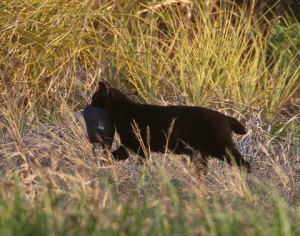Feral Cats
Feral cats (Felis catus)
Feral Cats are wild-living variant of the common pet cat, introduced to Hawai‘i by Europeans. Feral cats have established populations on all eight of the main Hawaiian Islands and contribute to widespread ecological disruptions that threaten native Hawaiian wildlife. Feral cats are one of the most devastating predators of Hawai‘i’s unique wildlife. In addition to direct predation, feral cats also spread a potentially lethal parasite (Toxoplasma gondii) that contaminates terrestrial, freshwater, and marine environments and has been shown to negatively impact birds and mammals – including humans.

A feral cat at Honouliuli (Oahu) with a dead Hawaiian coot (federally listed endangered species). This cat has a notched ear, indicating that it is part of a managed colony. Credit: Michael Walther
Description
Feral cats are identical to the common pet cat and are actually the same species separated only by lifestyle and behavior. Feral cats may utilize human resources or live completely independently and can be found in all types of habitat, including free-ranging in the mauka lands.
Impacts
-
Predator of native birds and insects. Predation is instinctive and means that even well-fed cats will hunt and kill wildlife. Prey include federally and State-listed endangered birds such as Palila (Loxioides bailleui), ‘Ua‘u (Hawaiian petrel; Pterodroma sandwichensis), ‘A‘o (Newell’s shearwater; Puffinus newelli), Koloa (Hawaiian duck; Anas wyvilliana), ‘Alae ‘ula (Hawaiian moorhen; Gallinula chloropus sandvicensis), and Ae‘o (Hawaiian stilt; Himantopus mexicanus knudseni).
-
Listed among the most harmful invasive species globally by the International Union for the Conservation of Nature. Feral cats on islands have contributed to the extinction of 33 species and are the principle threat to 8% of critically endangered birds, mammals, and reptiles.
-
Recognized as the top source of direct, human-associated mortality to birds in the United States. Each year, cats kill approximately 2.4 billion birds.
-
Required host for the parasite Toxoplasma gondii to complete its life cycle. A single cat may excrete hundreds of millions of infectious eggs into the environment through its feces. Humans, especially pregnant women and those with weakened immune systems, are vulnerable to infection by this parasite.
-
Toxoplasmosis is an identified threat to the conservation of endangered species such as Nēnē (Hawaiian goose; Branta sandvicensis), ‘Alala (Hawaiian crow; Corvus hawaiiensis), and Hawaiian monk seals (Monachus schauinslandi).
Distribution
Widespread on all the Main Hawaiian Islands in all habitats
What you can do
-
Spay and neuter pet cats.
-
Keep cats indoors or safely contained.
-
Microchip pet cats so that you may be reunited if the cats should become lost.
-
Never abandon pet cats. If you are no longer able to care for your pet, please surrender the cat to a local animal shelter so that it has a chance of being adopted.
-
Do not feed feral cats.
- On O‘ahu humane cat traps are available for loan from the Hawaiian Humane Society. Trapped cats can be brought to HHS for spay, neutering, vaccinations, and other health services. The HISC recommends spayed and neutered cats should then be brought home as indoor pets or offered for adoption, but not re-abandoned.
Additional Information
- HISC Resolution 19-2: Feral Cats and TNR
- Felis catus Datasheet from CABI
- American Bird Conservancy – Catios and other solutions for keeping pet cats indoors or in your yard
- American Bird Conservancy – Cats Indoors: A Conservation Movement
-
Lowe et al. 2000 – 100 of the world’s worst invasive alien species: a selection from the Global Invasive Species Database
- A Cat-astrophic Threat for Seals – How Toxoplasma gondii makes its way from mountain to ocean, NOAA Fisheries